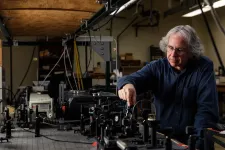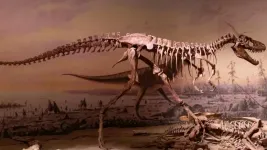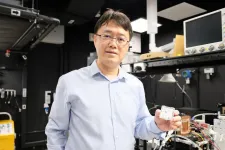Imaging space debris in high resolution
2021-02-25
(Press-News.org) Litter is not only a problem on Earth. According to NASA, there are currently millions of pieces of space junk in the range of altitudes from 200 to 2,000 kilometers above the Earth's surface, which is known as low Earth orbit (LEO). Most of the junk is comprised of objects created by humans, like pieces of old spacecraft or defunct satellites. This space debris can reach speeds of up to 18,000 miles per hour, posing a major danger to the 2,612 satellites that currently operate at LEO. Without effective tools for tracking space debris, parts of LEO may even become too hazardous for satellites.
In a paper publishing today in the SIAM Journal on Imaging Sciences, Matan Leibovich (New York University), George Papanicolaou (Stanford University), and Chrysoula Tsogka (University of California, Merced) introduce a new method for taking high-resolution images of fast-moving and rotating objects in space, such as satellites or debris in LEO. They created an imaging process that first utilizes a novel algorithm to estimate the speed and angle at which an object in space is rotating, then applies those estimates to develop a high-resolution picture of the target.
Leibovich, Papanicolaou, and Tsogka used a theoretical model of a space imaging system to construct and test their imaging process. The model depicts a piece of fast-moving debris as a cluster of very small, highly reflective objects that represent the strongly reflective edges of an item in orbit, such as the solar panels on a satellite. The cluster of reflectors all move together with the same speed and direction and rotate about a common center. In the model, multiple sources of radiation on the Earth's surface--such as the ground control stations of global navigation satellite systems--emit pulses that are reflected by target pieces of space debris. A distributed set of receivers then detects and records the signals that bounce off the targets.
The model focuses on sources that produce radiation in the X-band, or from frequencies of 8 to 12 gigahertz. "It is well known that resolution can be improved by using higher frequencies, such as the X-band," Tsogka said. "Higher frequencies, however, also result in distortions to the image due to ambient fluctuations from atmospheric effects." Signals are distorted by turbulent air as they travel from the target to receivers, which can make the imaging of objects in LEO quite challenging. The first step of the authors' imaging process was thus to correlate the data taken at different receivers, which can help reduce the effects of these distortions.
The diameter of the area encompassed by the receivers is called the physical aperture of the imaging system -- in the model, this is about 200 kilometers. Under normal imaging conditions, the physical aperture's size determines the resolution of the resulting image; a larger aperture begets a sharper picture. However, the quick movement of the imaging target relative to the receivers can create an inverse synthetic aperture, in which the signals that were detected at multiple receivers as the target moved throughout their field of view are synthesized coherently. This configuration can effectively improve the resolution, as if the imaging system had a wider aperture than the physical one.
Objects in LEO can spin on timescales that range from a full rotation every few seconds to every few hundred seconds, which complicates the imaging process. It is thus important to know--or at least be able to estimate--some details about the rotation before developing the image. The authors therefore needed to estimate the parameters related to the object's rotation before synthesizing the data from different receivers. Though simply checking all of the possible parameters to see which ones yield the sharpest image is technically feasible, doing so would require a lot of computational power. Instead of employing this brute force approach, the authors developed a new algorithm that can analyze the imaging data to estimate the object's rotation speed and the direction of its axis.
After accounting for the rotation, the next step in the authors' imaging process was to analyze the data to develop a picture of the space debris that would hopefully be as accurate and well-resolved as possible. One method that researchers often employ for this type of imaging of fast-moving objects is the single-point migration of cross correlations. Though atmospheric fluctuations do not usually significantly impair this technique, it does not have a very high resolution. A different, commonly-used imaging approach called Kirchhoff migration can achieve a high resolution, as it benefits from the inverse synthetic aperture configuration; however, the trade-off is that it is degraded by atmospheric fluctuations. With the goal of creating an imaging scheme that is not too heavily affected by atmospheric fluctuations but still maintains a high resolution, the authors proposed a third approach: an algorithm whose result they call a rank-1 image. "The introduction of the rank-1 image and its resolution analysis for fast-moving and rotating objects is the most novel part of this study," Leibovich said.
To compare the performance of the three imaging schemes, the authors gave simulated data of a rotating object in LEO to each one and compared the images that they produced. Excitingly, the rank-1 image was much more accurate and well-resolved than the result of single-point migration. It also had similar qualities to the output of the Kirchhoff migration technique. But this result was not entirely surprising, given the problem's configuration. "It is important to note that the rank-1 image benefits from the rotation of the object," Papanicolaou said. Though a rotating object generates more complex data, one can actually incorporate this additional information into the image processing technique to improve its resolution. Rotation at certain angles can also increase the size of the synthetic aperture, which significantly improves the resolution for the Kirchhoff migration and rank-1 images.
Further simulations revealed that the rank-1 image is not easily muddled by errors in the new algorithm for the estimation of rotation parameters. It is also more robust to atmospheric effects than the Kirchhoff migration image. If receivers capture data for a full rotation of the object, the rank-1 image can even achieve optimal imaging resolution. Due to its good performance, this new imaging method could improve the accuracy of imaging LEO satellites and space debris. "Overall, this study shed light on a new method for imaging fast-moving and rotating objects in space," Tsogka said. "This is of great importance for ensuring the safety of the LEO band, which is the backbone of global remote sensing."
INFORMATION:
Source article: Leibovich, M., Papanicolaou, G., & Tsogka, C. (2021). Correlation Based Imaging for Rotating Satellites. SIAM J. Imag. Sci., 14(1), 271-303.
[Attachments] See images for this press release:

ELSE PRESS RELEASES FROM THIS DATE:
2021-02-25
The unprecedented cost of the 2018 Kilauea eruption in Hawai'i reflects the intersection of distinct physical and social phenomena: infrequent, highly destructive eruptions, and atypically high population growth, according to a new study published in Nature Communications and led by University of Hawai'i at Mānoa researchers.
It has long been recognized that areas in Puna, Hawai'i, are at high risk from lava flows. This ensured that land values were lower in Puna--which lies within the three highest risk lava hazard zones 1, 2 and 3--which actively promoted rapid population ...
2021-02-25
Our body consists of 100 trillion cells that communicate with each other, receive signals from the outside world and react to them. A central role in this communication network is attributed to receiver proteins, called receptors, which are anchored at the cell membrane. There, they receive and transmit signals to the inside of the cell, where a cell reaction is triggered.
In humans, G protein-coupled receptors (GPC receptors) represent the largest group of these receptor molecules, with around 700 different types. The research of the Frankfurt and Leipzig scientists focused on a GPC receptor that serves as a receptor for the ...
2021-02-25
Timothy Callaghan, PhD, and Alva Ferdinand, DrPH, JD, from the Southwest Rural Health Research Center at Texas A&M University School of Public Health, joined colleagues in the first national study of how often people in urban and rural areas in the United States follow COVID-19 guidelines. These include public health best practices like wearing masks in public, sanitizing homes and work areas, maintaining physical distancing, working from home and avoiding dining in restaurants or bars.
The research team used a survey of 5,009 U.S. adults that closely matched the makeup of the country's population as a whole. The survey asked how often participants followed COVID-19 prevention recommendations and collected data on political ideology, perceived risk ...
2021-02-25
ITHACA, N.Y. - A team from Cornell University's Environmental Systems Lab, led by recent graduate Allison Bernett, has put forth a new framework for injecting as much information as possible into the pre-design and early design phases of a project, potentially saving architects and design teams time and money down the road.
"(Our framework) allows designers to understand the full environmental impact of their building," said Bernett, corresponding author of "Sustainability Evaluation for Early Design (SEED) Framework for Energy Use, Embodied Carbon, Cost, and Daylighting Assessment" which published Jan. 10 in the Journal of ...
2021-02-25
WEST LAFAYETTE, Ind. -- Doppler radar improves lives by peeking inside air masses to predict the weather. A Purdue University team is using similar technology to look inside living cells, introducing a method to detect pathogens and treat infections in ways that scientists never have before.
In a new study, the team used Doppler to sneak a peek inside cells and track their metabolic activity in real time, without having to wait for cultures to grow. Using this ability, the researchers can test microbes found in food, water, and other environments to see if they are pathogens, or help them identify the right medicine to treat antibiotic-resistant bacteria.
David Nolte, Purdue's Edward ...
2021-02-25
HOUSTON - (Feb. 25, 2021) - Low-income livestock farmers in developing countries are often faced with a difficult dilemma: protect their animals from endangered predators, or spare the threatened species at the expense of their livestock and livelihood.
A new paper by Rice University economist Ted Loch-Temzelides examines such circumstances faced by farmers in Pakistan. "Conservation, risk aversion, and livestock insurance: The case of the snow leopard" outlines a plan under which farmers can protect themselves from crippling financial losses while ...
2021-02-25
While the amazing regenerative power of the liver has been known since ancient times, the cells responsible for maintaining and replenishing the liver have remained a mystery. Now, research from the Children's Medical Center Research Institute at UT Southwestern (CRI) has identified the cells responsible for liver maintenance and regeneration while also pinpointing where they reside in the liver.
These findings, reported today in Science, could help scientists answer important questions about liver maintenance, liver damage (such as from fatty liver or alcoholic liver disease), and liver cancer.
The liver performs vital functions, including chemical detoxification, blood protein production, bile excretion, and regulation of energy metabolism. Structurally, the liver ...
2021-02-25
Paleo-ecologists from The University of New Mexico and at the University of Nebraska-Lincoln have demonstrated that the offspring of enormous carnivorous dinosaurs, such as Tyrannosaurus rex may have fundamentally re-shaped their communities by out-competing smaller rival species.
The study, released this week in the journal Science, is the first to examine community-scale dinosaur diversity while treating juveniles as their own ecological entity.
"Dinosaur communities were like shopping malls on a Saturday afternoon ? jam-packed with teenagers" explained Kat Schroeder, a graduate student in the UNM Department of Biology who led the study. "They made up a significant portion of the individuals in a species and would have had a very real impact ...
2021-02-25
An international team of scientists has developed a system that can generate random numbers over a hundred times faster than current technologies, paving the way towards faster, cheaper, and more secure data encryption in today's digitally connected world.
The random generator system was jointly developed by researchers from Nanyang Technological University, Singapore (NTU Singapore), Yale University, and Trinity College Dublin, and made in NTU.
Random numbers are used for a variety of purposes, such as generating data encryption keys and one-time ...
2021-02-25
As Covid-19 impacts lives around the world- a new skeleton study is reconstructing ancient pandemics to assess human's evolutionary ability to fight off leprosy, tuberculosis and treponematoses with help from declining rates of transmission when the germs became widespread.
The researchers state the germs mutated to infect ancient humans so they could replicate- hopping across to as many new hosts as possible- but the severity of the diseases reduced as a result.
The analysis by Adjunct Professor in Archaeology Maciej Henneberg and Dr Teghan Lucas at Flinders ...
LAST 30 PRESS RELEASES:
[Press-News.org] Imaging space debris in high resolution





